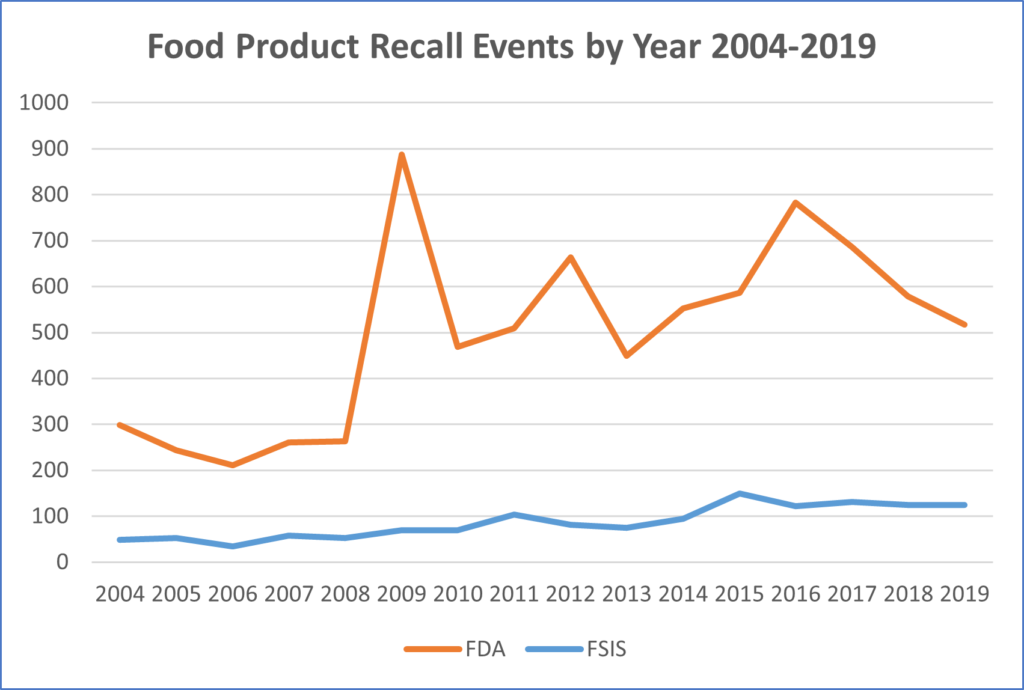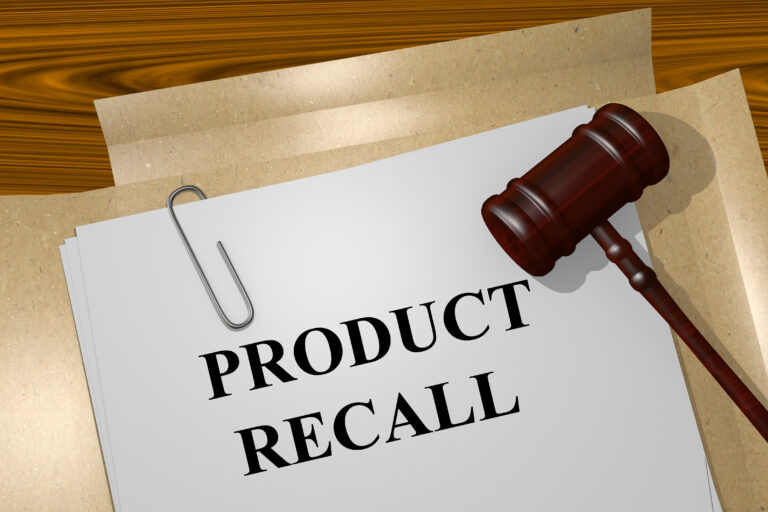On January 13, 2009, the Peanut Corporation of America (PCA) announced a recall of some lots of peanut butter for potential Salmonella contamination. Through a continuing series of expansions, there were ultimately over 3,600 products recalled that were made with products produced at the Blakely, Ga., plant since January 1, 2007. With the more than 700 people in 47 states sickened by Salmonella linked to PCA products; nine possible linked deaths; and the eventual trials, company shutdown and bankruptcy, and imprisonment of PCA executives, the event is now seen as a milestone in the history of the food industry, comparable to the Jack in the Box E. coli outbreak of 1993. And as tends to happen when milestones occur, the world – at least that of the food industry – was changed.
By the end of 2009 FDA recall events had hit a peak that the U.S. hasn’t seen since, but the rate of recall events has never fallen back to pre-2009 numbers.


Sources: 2004-2013, USDA 2014-2019, FDA 2014-2019
However, this should not be taken to mean that foods are riskier today than they were in the first decade of the century. Rather, as is stated in the 2018 recall trends report from the USDA Economic Research Service, “an increasingly complex food supply system, technology improvements in health risk detection, increased regulatory oversight and enforcement, and the passing of two major food policy laws (FALCPA and FSMA) may have all contributed to the significant rise in food recalls.” That report focused on 2004 to 2013 recalls, so TAG has compiled and added data through 2019 to enable an even more updated look at recalls. While we have seen a steady decline in FDA recalls since 2016, FSIS recalls have maintained a steadier pace, and both remain at significantly higher levels than those of pre-2009.
So, let’s take a look at the rationale of the report. In addition to logging the sheer numbers, the study analyzed recall events over time by type of foods, health risks, severity of the health risks, and geographic distribution of recalled products. As such, the report proposes four possible factors as being key to the increase:
- Increasingly complex food supply system. Ingredient-driven recall events have been the source of several extreme time trend outliers. Recalls of upstream ingredients can expand exponentially and impact dozens, if not hundreds, of downstream manufacturers that use the implicated ingredients. Thus, the report states that the widespread impact of these expanded recalls suggests that high-risk ingredients that are shipped to multiple manufacturers through various marketing channels for consumption in various settings may require greater oversight to prevent disastrous ripple effects for downstream manufacturers.
- Technology improvements in health risk detection. Pathogen detection has continued to improve through the years with detection capabilities often exceeding those of prevention and rapid-detection methods becoming more time efficient, sensitive, specific, and labor saving when compared with older, conventional methods. Additionally, downstream foodservice and retail customers increasingly require food manufacturers to undergo external audits, which have been associated with greater use of food safety testing and equipment technologies. With the further addition of FDA’s new focus on traceability technologies in its New Era of Smarter Food Safety plan, it becomes evident that technological advances are, or certainly should be, increasing the ability to detect risks.
- Increased regulatory oversight and enforcement. Although the report saw the inspection efforts of federal and state agencies as potentially having an impact on the number of recall events, the rate of inspections has gradually decreased since 2004 in both number of facilities inspected and percent of facilities subject to inspection being inspected. With a high of 29% facilities inspected in 2004, the rates shifted between 22% to 25% between 2005 and 2012, then falling to a high of 20% in successive years recorded. So while TAG does not quite see that in the same lens as that of the report, we would agree that regulatory oversight and enforcement has increased, but likely due more to regulatory action, such as that in the next bullet.
- The passing of two major food policy laws.
- The Food Allergen Labeling and Consumer Protection Act (FALCPA) of 2004, effective January 1, 2006, requires all food labels to list all major allergens. Thus, FALCPA likely played a major role in the dramatic increase in the number of undeclared allergen recalls – which have consistently been a leading cause of food recalls. Given the consumer impact and massive expense recalls can present, this finding suggests that more time and effort spent reviewing labels to ensure they are accurate prior to sale would likely contribute to a reduction in recalls.
- As the most sweeping reform of food safety law in over 70 years, FDA Food Safety Modernization Act (FSMA) undoubtedly has had an impact. Under FSMA, the FDA, for the first time, has the authority to impose a mandatory recall and shut down operations at food production facilities. While FDA has rarely exercised this authority, it has the potential to change producer incentives to voluntarily disclose and recall risky products before being mandated to do so, which may have factored into the increase of food recalls following its enactment.
In addition to these, TAG would see the significant milestones, such as the PCA event, and the resulting repercussions as also likely having an impact. While we would hope that such recalls would lead to lessons learned and preventive actions across the food industry, the fear factor of closure, bankruptcy, and/or executive imprisonment can be a very strong incentive to do things right.
As shown in the table and graph, recent years have seen a reduction in recalls, somewhat belying the above rationale for the overall increase. And TAG sees this as a positive sign – that the industry is learning to work with the complex food supply system, ever-lowering detection capability and other technologies, regulatory oversight, and overall regulation to make its food safer, thereby reducing recalls and consumer risk.
Overall, the challenges for the food industry have continued to grow in recent years with wider use of molecular technology such as Whole Genome Sequencing and the more stringent regulatory requirements as noted above. The last two years of COVID have imposed even more pressure on the food industry related to labor shortages, labor costs, supply chain challenges and other costs associated with making and selling food. We at TAG do not see this pressure reducing in the near future, so looking at ways to adjust to the challenges is one key to long-term success which involves taking a look at your programs, your regulatory compliance and your food safety culture overall. By doing that you can at least minimize the risks that something will catch you unexpectedly and result in a recall.





